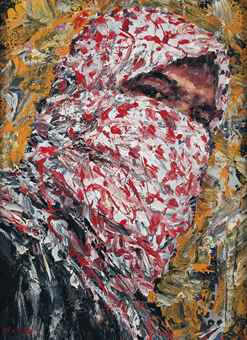Given its location
between the Arab countries, Africa, and Europe, Lebanon’s culture shares bits
and pieces of all three of these regions. During the 19th century
and early 20th centuries—even before the French mandate—painting was
quite a popular art form in Lebanon. One painter stood out from the rest:
Mustafa Farroukh. He traveled to Rome to study art and continued his studies in
Paris. And while he traveled to exhibitions in Venice, New York, and Spain, he
was highly esteemed in Beirut. Later on, he wrote several books and taught art at
the American University of Beirut.
After the Civil War
(1975–1990), contemporary artists began to emerge in droves. Soon money began
to be put into art galleries, exhibitions, and commissions for public art.
Beirut became an artist’s town. Some of the contemporary artists of note
include Walid Raad (video, photography, media), Ayman Baalbaki (expressionist
painting), Akram Zaatari (filmmaker, photographer), Nadim Asfar (photographer,
filmmaker), Lamia Joreige (painting, photography, video), Ricardo Mbarkho
(digital artist), and Hanibal Srouji (painting).
One of the things
about living in an area that has seen many changes in who controls the land is
the influence on their architecture. A Druze prince who was exiled to Italy
ended up coming back to Lebanon, modernizing the country by setting up
factories and businesses based on what he saw while in Italy. Beirut and Sidon
were two of the main cities to see this Italian (and especially Tuscan)
influence on their architecture. The Phoenicians would also have a keen influence
on their building styles. The Ottoman Empire spread far and wide and included
Lebanon at one time, leaving bits and pieces of their culture and architecture
on the Lebanese (as they did wherever they went). When the French took control
of the area, they added their own French flair to buildings they erected while
Lebanon was placed under a French mandate. Although some of these buildings
have been destroyed through wars and through time, there are still many great
examples of the centuries of foreign influence on Lebanese architecture,
especially in the larger cities.
Much of Lebanese
literature is mostly written in either Arabic, French, or English. And most of
what’s been produced has been since the late 19th century. By far
one of the most influential Lebanese writers is Gibran Khalil Gibran. His book The Prophet (1923) was written in
English and was widely popular despite the meh opinions of critics at the time
(it goes to show what critics know). Gibran made a name for himself as a rebel
and literary revolutionary. He ditched the classical style of writing in lieu
of more modern prose-style poetry. Gibran’s poetry was given a second wave of
interest during the 1960s counterculture revolutions. Gibran Khalid Gibran’s
poems are the third best-selling poems in the world, after Shakespeare and Lao-tzu.
Today, there are a
number of successful writers from Lebanon—both men and women. Many people who
study Arabic literature note that the writers of Lebanon have a certain flair
in their writing. There is a respect for the poetic nature of the language, and
they use the language to the writer’s benefit. Lebanese writers excel in a
variety of genres, from memoirs to historical novels to graphic novels to
journalism. I came across one article written by a doctoral student regarding
children’s literature. He basically said that the vast majority of children’s
literature is written in Modern Standard Arabic (MSA), but its style is far
more classical than what people actually speak in Lebanon, and this can be
somewhat problematic for children who are still learning the language. They
need something they hear everyday to be reinforced. So, essentially, it’s up to
the parent to be able to translate on the fly into Lebanese. I suppose it’s as
if the majority of children’s literature were written in Shakespearean English
or Chaucerian English. It really made me think of the function of language. But
as a friend of mine pointed out, it’s probably true across the Arab world:
local Arabic dialects can be quite different from Modern Standard Arabic, but
children also need to be exposed to both varieties.
Up next: music and
dance




No comments:
Post a Comment